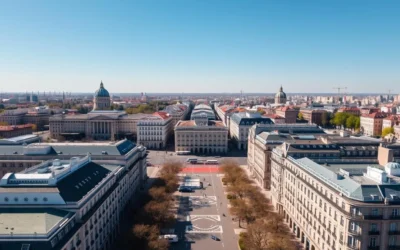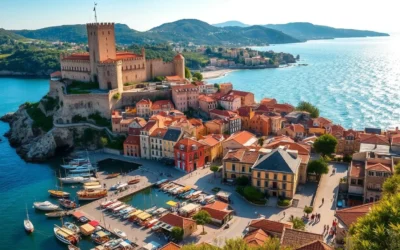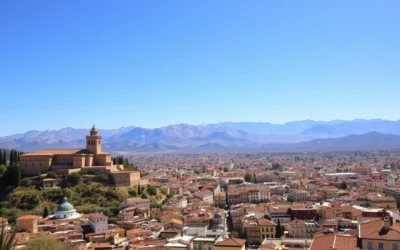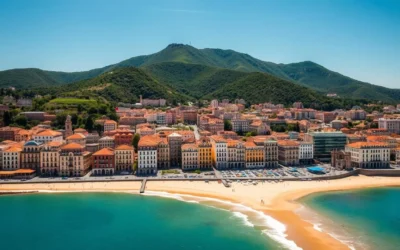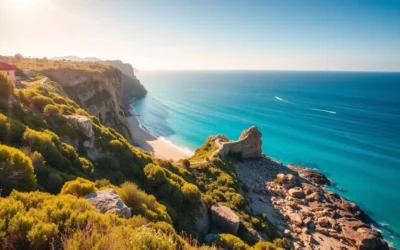✓ Accommodations✓ Flights✓ Rental Cars✓ Tours & Activities
You might have heard that Bilbao, nestled in northern Spain’s Basque Country, is a hidden gem. Many travelers overlook it in favor of nearby San Sebastián, but that’s a mistake. This vibrant city has undergone significant transformation from its industrial past to become a cultural and architectural marvel.
As you explore Bilbao, you’ll discover a unique blend of traditional Basque culture and modern cosmopolitan charm. In just 24 hours, you can stroll through the downtown core, visit the world-famous Guggenheim Museum, and enjoy the city’s renowned food scene. Whether you’re looking for a quick city break or a longer exploration of northern Spain, Bilbao has something for everyone.
With its stunning architecture, vibrant culture, and incredible food, this city is sure to leave a lasting impression on you.
Discovering Bilbao: Spain’s Reinvented Northern Gem
Located in the Basque Country, Bilbao is a city that has reinvented itself, showcasing a blend of history and modern architecture. As you explore this vibrant city, you’ll discover its fascinating transformation from a gritty industrial port city to one of Spain’s most exciting cultural destinations.
Bilbao is situated along the Nervión River, about 16 kilometers inland from the Bay of Biscay in northern Spain. This strategic location has played a significant role in the city’s history, dating back to its founding in 1300 by Diego López V de Haro, Lord of Biscay. The city’s rise as a commercial hub facilitated trade between Spain and northern Europe, contributing to its growth.

The 19th and early 20th centuries saw Bilbao become an industrial powerhouse, leading to rapid urbanization. However, the late 20th century marked a shift toward cultural and architectural rejuvenation, spearheaded by the opening of the Guggenheim Museum in 1997. This transformation has made Bilbao a must-visit destination, maintaining its distinct Basque identity while embracing modern design.
As you visit Bilbao, you’ll experience a unique cultural blend that sets it apart from other Spanish cities. The city’s ability to balance its rich history with innovative architecture makes it a compelling destination in northern Spain.
How to Get to Bilbao

Getting to Bilbao is easier than you think, with multiple transportation options available. You can reach Bilbao by car via major roads, with the city being approximately 1 hour from San Sebastián via the AP-8 highway.
The city is also well-connected by train, with Bilbao’s Abando Indalecio Prieto Station offering services from major Spanish cities like Madrid (~5 hours) and Barcelona (~6.5 hours) via Renfe.
Alternatively, you can fly into Bilbao Airport (BIO), which is located just 12 km north of the city center and offers numerous domestic and international flights, making your trip to Bilbao convenient.
Once you arrive, the compact nature of the city and its excellent public transportation system make it easy to explore without a car, allowing you to enjoy your stay in this beautiful city.
Best Time to Visit Bilbao
Bilbao, a city in northern Spain, is a year-round destination, but the best time to visit depends on your preferences. The city‘s climate is mild, making it pleasant for tourists throughout the year.
The ideal time to visit Bilbao is during late spring (May-June) and early fall (September-October), when the weather is pleasant and tourist crowds are smaller. Summer (July-August) brings warmer temperatures and more tourists, but it’s also the season for exciting festivals and events that might appeal to cultural travelers.
| Season | Weather | Tourist Crowds |
|---|---|---|
| Late Spring (May-June) | Pleasant | Smaller |
| Summer (July-August) | Warmer | More |
| Early Fall (September-October) | Pleasant | Smaller |
It’s worth noting that Bilbao’s winters are mild compared to other parts of northern Spain, with temperatures rarely dropping below freezing. However, the city receives more rainfall than southern Spain, particularly in late fall and winter, so packing rain gear is advisable. If you’re planning to combine your visit with beach time, aim for the summer months when the nearby coastal areas are at their best.

Where to Stay in Bilbao

Choosing the right neighborhood to stay in Bilbao can greatly enhance your travel experience. The city is compact and walkable, with great public transport, making it easy to access top attractions from any place you choose to stay.
For a sleek and modern stay, Abando is the top choice, especially for those who want to be close to the Guggenheim Museum. This area is home to high-end hotels and stylish restaurants, offering easy access to the Nervión River.
If you prefer a more historic and atmospheric setting, Casco Viejo (the Old Town) is the best place to stay. You’ll find charming boutique hotels and lively pintxos bars, making it perfect for food lovers.
For a balance of culture, nightlife, and convenience, Indautxu is a great option, located near Gran Vía, Bilbao’s main shopping street. This district is bustling with locals and offers a mix of trendy cafés, bars, and cultural spots.
Whether you’re looking for luxury, history, or a lively atmosphere, Bilbao has a neighborhood that suits your travel style, right in the heart of the old town or elsewhere.
The Iconic Guggenheim Museum
With its shimmering titanium cladding, the Guggenheim Museum is an unmissable attraction in Bilbao. As the undisputed symbol of Bilbao’s urban transformation, the museum has been a catalyst for the city’s renaissance since its opening in 1997.

The museum’s design, crafted by Frank O. Gehry, features 35,000 sheets of titanium that shimmer and change color depending on the light and weather conditions. The exterior of the museum is as much a work of art as the collections inside, with outdoor installations like Jeff Koons’ flower-covered “Puppy” and Fujiko Nakaya’s “Fog Sculpture.”
Must-See Exhibits at the Guggenheim
One of the museum’s most striking features is Richard Serra’s “The Matter of Time,” a series of massive weathered-steel sculptures housed in a dedicated 130-meter gallery. You can wander through and around this maze-like installation, experiencing the art in a unique and immersive way.
The Guggenheim Museum’s collection rotates frequently with temporary exhibitions, but the building itself remains the star attraction. As you explore the museum, you’ll discover a vast collection of modern and contemporary art, featuring Spanish and international artists.
The Guggenheim Museum is a must-visit destination in Bilbao, offering an unforgettable experience that combines stunning architecture, innovative art, and captivating sculptures.
Exploring Casco Viejo: Bilbao’s Historic Quarter
Casco Viejo, or ‘Siete Calles,’ is the historic heart of Bilbao, where you can explore narrow streets, visit iconic landmarks, and enjoy local cuisine. This ancient neighborhood is an intricate network of streets that make up the city’s oldest and possibly liveliest area.

Located close to the estuary, Casco Viejo is home to Bilbao’s most iconic historical monuments, including the Santiago Cathedral and the Church of San Antón. The area was declared a Historic-Artistic Monument in 1972, recognizing its cultural and historical significance.
Santiago Cathedral and Religious Sites
The Santiago Cathedral is the Basque Country’s greatest Gothic monument, built over 600 years ago with a remarkably uniform architectural style despite its century-long construction. You can admire its three entrances and attend bilingual Masses on Sundays. Another significant site is the Church of San Antón, which appears on Bilbao’s coat of arms and features a mix of Gothic, Renaissance, and Baroque elements.
Casco Viejo offers visitors a journey through Bilbao’s history while serving as the city’s most vibrant social hub, where historic architecture meets contemporary Basque life. You can enjoy a glass of wine and savor Basque-style tapas known as ‘pintxos’ in this lively neighborhood.
Bilbao, Spain: Best Things to Do – Top Picks for Food Lovers

As a food lover’s paradise, Bilbao boasts an array of pintxos bars that are sure to tantalize your taste buds. The city’s culinary scene is deeply rooted in Basque traditions, with a focus on fresh, local ingredients and creative flavor combinations.
The pintxos culture in Bilbao is all about hopping from bar to bar, sampling specialties like Gilda (anchovy, olive, and pickled pepper skewers) and bacalao (salt cod). You’ll find these bars concentrated in areas like Casco Viejo and Plaza Nueva, where the atmosphere is lively and the food is delicious.
Mercado de la Ribera: Europe’s Largest Covered Market
One of Bilbao’s culinary highlights is the Mercado de la Ribera, Europe’s largest covered market. Located on the right-hand bank of the river Nervión, this stunning Art Deco building is home to a variety of traditional food stalls and modern gastrobars. Here, you can sample local specialties, listen to jazz music, and soak up the vibrant atmosphere.
Beyond pintxos, Bilbao offers a range of Basque specialties, including txuletón (aged beef steak), kokotxas (hake or cod cheeks), and the famous burnt Basque cheesecake. Be sure to pair your meal with a glass of txakoli, a slightly sparkling white wine that’s traditionally poured from a height to enhance its crispness.
Riverside Walks and Architectural Wonders
The Nervión River forms the backbone of Bilbao, offering a unique perspective on the city’s evolution. As you stroll along its banks, you’ll discover how the river divides the city into two distinct areas: the historic quarter and the Ensanche.
The riverside promenades are a great way to experience Bilbao’s architectural blend, from historic buildings to modern designs. Notable bridges like Santiago Calatrava’s striking white Zubizuri (White Bridge) with its glass walkway and sail-like design add to the city’s charm.

As you walk along the river, you’ll pass by vibrant public spaces with art installations, cafes, and green areas, showcasing the city’s transformation from industrial zones to beautiful waterfront spaces. This route offers constantly changing views of Bilbao’s skyline, making it a memorable experience.
- Explore the river’s meandering banks and discover Bilbao’s history.
- Cross the iconic bridge designs that span the river.
- Enjoy the city’s evolving architecture along the promenades.
Bilbao’s Fine Arts Museum: A Hidden Gem

While the Guggenheim Museum often steals the spotlight, Bilbao’s Fine Arts Museum is a treasure trove of art waiting to be discovered. This museum was formed in 1945 by merging the original Fine Arts Museum (founded in 1914) and the Museum of Modern Art (created in 1924), giving it a rich historical significance.
The Fine Arts Museum boasts an impressive collection of over 10,000 works of art, spanning from the 12th century to contemporary pieces. You can explore a diverse range of displays, including ancient, classical, modern, and contemporary art sections. The museum is particularly strong in Spanish and Basque art, featuring masterpieces from renowned artists like El Greco, Goya, Sorolla, and Francis Bacon.
To fully appreciate the museum’s vast collection, plan to spend at least two hours exploring its many displays. This will give you a comprehensive understanding of the art historical experience that the Fine Arts Museum offers, which is distinct from the Guggenheim.
Mount Artxanda: Panoramic Views of Bilbao

If you’re looking for a panoramic view of Bilbao, Mount Artxanda is the place to be. This vantage point offers a stunning vista of the city nestled in its green valley, with the Nervión River winding through it. You can reach the summit via the historic Artxanda Funicular, a quick 3-minute ride that has been operating since 1915.
The viewing platforms at the top provide 360-degree vistas of the city skyline and surrounding mountains. On clear days, you can even catch a glimpse of the Bay of Biscay. After taking in the views, enjoy traditional Basque cuisine at one of the restaurants or cafes at the summit.
For the most dramatic lighting, visit Mount Artxanda at sunset, when the Guggenheim’s titanium panels glow golden in the evening light. This makes for a memorable trip and a great way to spend an hour taking in the city’s beauty.
Centro Azkuna: From Wine Warehouse to Cultural Hub
As you explore Bilbao, a visit to the Centro Azkuna is a must, offering a unique blend of history, architecture, and culture. This former wine warehouse, built in the Modernista style, has been transformed into a vibrant cultural center.
The remodeling by Philippe Starck has resulted in a multi-purpose facility featuring galleries, cinemas, a gymnasium, and restaurants. The ‘Atrio de las Culturas’ [Culture Atrium] is a striking space with 43 uniquely designed columns, while the ‘Terraza del Sol’ [Sun Terrace] boasts a swimming pool with a transparent floor.
Centro Azkuna represents Bilbao’s commitment to cultural revitalization, providing a space where locals and visitors come together. You can enjoy various activities, from browsing the media library to relaxing at the rooftop Sun Terrace with views of the city.
| Facilities | Description |
|---|---|
| Culture Atrium | A huge square with 43 columns in different styles |
| Sun Terrace | Rooftop pool with a transparent floor |
| Media Library | A vast collection of media resources |

Day Trips from Bilbao

With Bilbao as your starting point, you can uncover the charm of the Basque region through a variety of day trips. The region is rich in cultural heritage and breathtaking landscapes, making it an ideal destination for travelers.
One of the must-visit destinations is San Juan de Gaztelugatxe, a stunning coastal marvel that was famously featured in Game of Thrones.
San Juan de Gaztelugatxe: A Coastal Marvel
San Juan de Gaztelugatxe is a breathtaking coastal hike destination, boasting a beautiful hermitage on a rocky islet. This site is connected to the mainland by a man-made bridge and is a significant cultural landmark in the region.
Other exciting day trip options include San Sebastián, renowned for its culinary delights and one of the highest concentrations of Michelin-starred restaurants worldwide. You can also explore the La Rioja Wine Region by joining a guided tour that allows you to taste some of Spain’s finest wines.
Additionally, destinations like Vitoria-Gasteiz, the Urdaibai Biosphere Reserve, and the charming coastal towns along the Bay of Biscay offer a mix of culture, history, and natural beauty. Each of these day trips can be completed within a few hours, making them perfect for travelers looking to experience the diversity of the Basque Country.
Exploring Bilbao by Boat

Discover Bilbao from a different perspective with a boat tour along the Nervión River. This gentle boat ride introduces you to Bilbao’s maritime and industrial past, offering a fascinating glimpse into the city’s evolution.
Various boat tour options are available, including regular services operated by El Bote and Bilboats, which provide commentary on the city’s history and architecture. As you cruise along the river, you’ll pass beneath the famous Vizcaya Bridge, a UNESCO World Heritage Site since 2006.
Key sights visible from the water include the Guggenheim Museum, historic loading docks, and the various bridges spanning the river. Timing your boat trip for sunset creates a magical atmosphere, with the light on the water and illuminated buildings.
Bilbao for Art and Architecture Enthusiasts
Bilbao’s transformation into a vibrant cultural hub is evident in its stunning architecture and world-class art museums. As you explore the city, you’ll discover a rich design landscape that goes beyond the iconic Guggenheim Museum. Renowned architects like Norman Foster and Frank O. Gehry have left their mark on Bilbao, with landmarks like Foster’s metro stations and Gehry’s Guggenheim Museum.
| Landmark | Architect | Description |
|---|---|---|
| Zubizuri Bridge | Santiago Calatrava | A striking example of modern architecture |
| Metro Stations | Norman Foster | Futuristic designs that blend functionality and aesthetics |
| Centro Azkuna | Philippe Starck | A transformed wine warehouse turned cultural hub |
To experience the best of Bilbao’s art and architecture, consider a walking tour that highlights public art installations along the riverfront, including works by Eduardo Chillida. For a deeper understanding of the city’s architectural renaissance, join a guided tour that explores Bilbao’s impact on urban planning worldwide.

Practical Tips for Visiting Bilbao
To make the most of your visit to Bilbao, it’s essential to be prepared with some practical tips. The city’s clean and efficient metro system makes it easy to get around. Consider purchasing a Bilbao Card, which offers free public transportation and discounted entry to major attractions for 24, 48, or 72 hours.
To avoid crowds, plan your tour of popular attractions like the Guggenheim early in the morning. Visiting Casco Viejo outside of peak dining hours can also enhance your experience.
| Tip | Benefit |
|---|---|
| Use Metro | Easy city navigation |
| Bilbao Card | Discounts and free transport |
| Early Guggenheim visit | Avoid crowds |

Conclusion: Why Bilbao Deserves More Than a Day Trip
As I explored Bilbao, I realized that this vibrant city has a depth that can’t be fully appreciated in just 24 hours. Between its diverse neighborhoods, world-class museums, and thriving food scene, there’s so much to discover. Bilbao’s transformation from industrial decline to cultural prominence is a testament to its resilience and charm.
To truly experience the best of Bilbao, I recommend spending at least 2-3 days exploring its many places and trying the local pintxos. Visit the Guggenheim, wander through Casco Viejo, and take a day trip to San Juan de Gaztelugatxe. With its unique Basque character and blend of tradition and innovation, Bilbao is a city that has many things to offer, making it an unforgettable destination.
The above is subject to change.
Check back often to TRAVEL.COM for the latest travel tips and deals.


